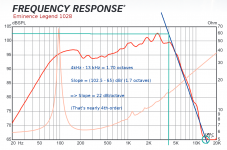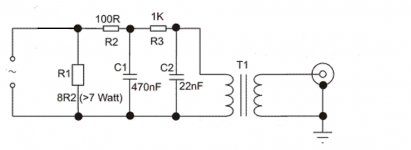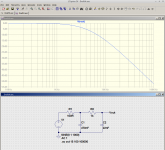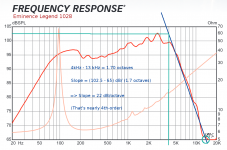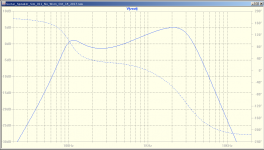Well my 10 watt amp can only produce about 9v out so a 1:10 divider should be under 1v. I have done this before and the resistors may very well still be hooked up, I had zero noise issues. The only issue I remember running into was the top end didn't sound very good. I reckon since it's a pentode amp with zero global feedback there was high distortion at higher frequencies which isn't noticed when using a guitar speaker because there isn't much above 5kHz. This is why I need a filter going to the board to get rid of the harsh top end, I think I added a cap and it helped. Maybe I should open my amp and see if I left the two resistors and cap in there. Basically a group I was playing with a few years ago wanted me to have a direct out on my amp so we could record our practices easily without mic'ing everything so I added a divider off the output to a jack to run unbalanced to the board. Worked good they loved it.
I certainly hates the ones that promise one hundred and fifty different classic valve amps in a box, but actually sound like one hundred and fifty different kinds of kazoo in one box.Yes we do hates digital modeling amps lol.
It would take a rather big cap - 3.2 uF - across a 10 ohm resistor to give you a 5 kHz cutoff frequency, which is probably somewhere in the ballpark for a crude guitar speaker emulator. It would have to be an unpolarized cap too.I think I can make a filter on the divider across the direct output. Say 100R/10R and parallel a cap with the 10R?
These days you can get a 3.3 uF multi-layer ceramic cap that will do the job for not much money.
But why not use 33k/3.3k for the voltage divider, and then put a 0.01uF cap across the 3.3k k? That will also get you 5 kHz, and the output resistance of roughly 3k will be quite low enough to feed any reasonable mixer or P.A. system. You can tune the frequency by varying the 3.3k resistor a bit, lower ohms for a higher frequency cutoff. Say 2.7k, or 2.2k, or 3.9 k, till you find a sound that satisfies you.
If you're going into an instrument-level input, 1 volt may be way too big. You could always add a second voltage divider fed by the first (maybe with a switch to bypass it) to cut the signal down to the 100 mV region.
By the way, one cap and one resistor is only going to get you a first-order low pass filter; in other words, it won't cut off the high treble as sharply as a typical guitar speaker does. But it will probably be at least a step in the right direction.
-Gnobuddy
By the way, one cap and one resistor is only going to get you a first-order low pass filter; in other words, it won't cut off the high treble as sharply as a typical guitar speaker does. But it will probably be at least a step in the right direction.
VC inductance is also acting as a 1st order filter.
I am told the drummer uses electronic drums although photos showed acoustic drums, probably old pictures on their web page.
I have my daughter's old Pearl Export drum set. It's far too loud to play in the basement, so as an experiment I picked up a mesh head. It's a rather subdued thud, but vibrates enough to set off a piezo drum trigger. Now if I could find a better way to turn down the cymbals other than a towel and some duck tape.
hates the ones that promise one hundred and fifty different classic valve amps in a box, but actually sound like one hundred and fifty different kinds of kazoo
I have this program in my PC called TH3 by a company called OverLoud. It a simulator of sorts and has several tones that sound nice, and a few that suck.....but the fake reverb and dial a twang does 60's surf music right.
I certainly hates the ones that promise one hundred and fifty different classic valve amps in a box, but actually sound like one hundred and fifty different kinds of kazoo in one box.
It would take a rather big cap - 3.2 uF - across a 10 ohm resistor to give you a 5 kHz cutoff frequency, which is probably somewhere in the ballpark for a crude guitar speaker emulator. It would have to be an unpolarized cap too.
These days you can get a 3.3 uF multi-layer ceramic cap that will do the job for not much money.
But why not use 33k/3.3k for the voltage divider, and then put a 0.01uF cap across the 3.3k k? That will also get you 5 kHz, and the output resistance of roughly 3k will be quite low enough to feed any reasonable mixer or P.A. system. You can tune the frequency by varying the 3.3k resistor a bit, lower ohms for a higher frequency cutoff. Say 2.7k, or 2.2k, or 3.9 k, till you find a sound that satisfies you.
If you're going into an instrument-level input, 1 volt may be way too big. You could always add a second voltage divider fed by the first (maybe with a switch to bypass it) to cut the signal down to the 100 mV region.
By the way, one cap and one resistor is only going to get you a first-order low pass filter; in other words, it won't cut off the high treble as sharply as a typical guitar speaker does. But it will probably be at least a step in the right direction.
-Gnobuddy
Yes I was trying to keep a low output impedance but having a high z out and a long cable will help me filter the highs out.
Rob Robinette suggests
It might be easier just putting a cap (or cap and pot) between the plates of your output tubes - have a look at Rob Robinette's High cut control or Vox Cut Control... will help me filter the highs out.
I use this when I use an amp.It is fantastic.
Amazon.com: A/DA GCS-3 Cabinet Simulator: Musical Instruments
Amazon.com: A/DA GCS-3 Cabinet Simulator: Musical Instruments
Thank you everyone for all the great advice and knowledge.
Maybe I awoke on the wrong side of the bed today but I think I am just going to bring my amp to the practice on Thursday and if they don't like it I will just leave. I figured this would be a fun exercise but stress from work has got me down and I shouldn't have to spend money on a gadget in lieu of my lovely amp just because these guys can't mix on stage monitors. The guy that runs the band is a friend of a friend and he is a nice guy and the band would be a good opportunity but I can't believe I am laying awake at night worrying about this. Nothing will compare to mic'd real amp with a real speaker, nothing.
Maybe I awoke on the wrong side of the bed today but I think I am just going to bring my amp to the practice on Thursday and if they don't like it I will just leave. I figured this would be a fun exercise but stress from work has got me down and I shouldn't have to spend money on a gadget in lieu of my lovely amp just because these guys can't mix on stage monitors. The guy that runs the band is a friend of a friend and he is a nice guy and the band would be a good opportunity but I can't believe I am laying awake at night worrying about this. Nothing will compare to mic'd real amp with a real speaker, nothing.
True, but that filter actually boosts treble (when fed from a high source impedance like a valve guitar amp). So it's not the cause of the high-frequency rolloff we see in guitar speakers.VC inductance is also acting as a 1st order filter.
The high-frequency acoustic rolloff comes from the mechanical breakup of the loudspeaker cone. Once the frequency is high enough, the cone is no longer stiff enough to move as one piece, so different parts of the cone flop around individually, and cancel each other's acoustic output.
So how steep is the rolloff caused by cone breakup modes? I wasn't 100% sure, so I grabbed the first guitar speaker frequency response that Google turned up (it happened to be for a 10" Eminence Legend 1028K ), plotted a few lines on it, and estimated the rate of treble rolloff above the big peak at roughly 3 kHz (the peak tells you where massive cone breakup starts to happen).
As you can see in the attached plot, the output falls from roughly 102.5 dB to 65 dB between roughly 4 kHz and 13 kHz. That calculates out to 37.5 dB in 1.7 octaves, or 22 decibels per octave.
A first order low-pass filter rolls off at 6 dB/ octave. 2nd order, 12 dB/octave. 3rd order, 18 dB/octave. 4th order, 24 dB/octave.
So 22 dB/octave is nearly as steep as a 4th order low-pass filter.
-Gnobuddy
Attachments
Yeah, that's no fun. I'm sorry to hear this is bothering you so much. I hope there is a happy ending for you and the rest of the band.I can't believe I am laying awake at night worrying about this.
-Gnobuddy
A first order low-pass filter rolls off at 6 dB/ octave. 2nd order, 12 dB/octave. 3rd order, 18 dB/octave. 4th order, 24 dB/octave.
So 22 dB/octave is nearly as steep as a 4th order low-pass filter.
I opened the amp up and I had a 100:10 resistor ratio and a 4.7uF non-polarized cap paralleling the 10 ohm resistor. From memory it didn't sound half bad, but that was with the speaker as a load still hooked up. You got me thinking I can at least make a steeper filter for the practice and see how things go. I found a 70v transformer and plan to use the 525:8 tap for the output. Attached is the proposed circuit. I will wire it up tomorrow and see how it sounds.
Yeah, that's no fun. I'm sorry to hear this is bothering you so much. I hope there is a happy ending for you and the rest of the band.
Thanks man. I think I was being a wimp this morning and feeling stressed lol. I usually don't mind projects and things to keep me busy but sometimes I just need to relax, which I did today for a bit. I still would just much rather just use my amp like a normal human being but I think these guys found an odd solution to a common problem and that's probably that every guitar player likes to be loud as hell and it can really drown out the dynamics in a band. We'll see where things go and I can come up with something more elaborate later if I stay with them.
Attachments
FWIW a large (8 to 10dB) peak between 2000 and 3500Hz , followed by lowpass 24dB/oct starting between 2500 and 4500Hz describes 99% of Guitar speakers .
12" ones have an around 1200 to 1500 Hz , 6 to 10 dB dip, depending on doping.
Most have a moderate bump (2 to 6 dB) at in cabinet resonance frequency , from 90 to 150Hz, depending on size.
Playing with these parameters you can simulate *any* standard Guitar speaker.
12" ones have an around 1200 to 1500 Hz , 6 to 10 dB dip, depending on doping.
Most have a moderate bump (2 to 6 dB) at in cabinet resonance frequency , from 90 to 150Hz, depending on size.
Playing with these parameters you can simulate *any* standard Guitar speaker.
I ran it through LTSpice just for fun. It's hard to make a crisp second order filter that's entirely passive (the "corner" is very rounded), but it should certainly remove more of the really high frequency nasties.You got me thinking I can at least make a steeper filter for the practice and see how things go.
Ain't that the truth! ("It's loud enough when everybody else has their fingers stuck in their ears and is grimacing in pain, dag nabbit!")...probably that every guitar player likes to be loud as hell...
I'm a guitar player myself, but I was forced to turn in my Guitarists Union card and be officially censured, just because I built myself a 2-watt amp!
-Gnobuddy
Attachments
Last edited:
Sounds like a fistful of caps, resistors, opamps and a few pots. Something like this in a little FX-pedal sized case might be a useful thing to have.Playing with these parameters you can simulate *any* standard Guitar speaker.
My old Superchamp XD has a factory line-out from the preamp. I looked at the factory schematic after I bought it (circa 2010 or so), and it had a 3rd-order lowpass filter (using two opamps) just before the line out.
I didn't know how to use LTSpice at the time, so I'm not sure of the corner frequency. I estimated it was around 4 - 5 kHz.
-Gnobuddy
I ran it through LTSpice just for fun. It's hard to make a crisp second order filter that's entirely passive (the "corner" is very rounded), but it should certainly remove more of the really high frequency nasties.
Ain't that the truth! ("It's loud enough when everybody else has their fingers stuck in their ears and is grimacing in pain, dag nabbit!")
I'm a guitar player myself, but I was forced to turn in my Guitarists Union card and be officially censured, just because I built myself a 2-watt amp.
Oh yea a 2 watt amp won't keep up in the majority of rock band scenarios when not mic'd.
Thanks for simulating that, I wanted to get around to it but I wanted to measure the inductance of the 70v transformer. I am thinking the highish impedance driving the transformer will form a high pass filter.
You might make the point that a guitar amp is part of the instrument. It's not just amplification. Not the same as a bass guitar or electronic drums, which can go right into the board.
I plan to. I know for a fact one of his complaints about the other guitar player is for not being aggressive and cutting through during solos. When listening to some live recordings of their gigs it sounds like part of that problem is tone related because he wasn't a bad player, he is a Berklee School of music graduate. Between my TS9 and my MXR Custom Compressor driving my amp I can make my Collings Soco Deluxe sing like a bird, I have sustain for days and I can cut through every instrument with a single note but at the same time when I play chords it's nice and compressed fall into the mix.
I couldn't agree more! It works for me because we make a quieter kind of music, a few plugged in acoustic-electric guitars, an (unmic'd) fiddle, vocals. No drums.Oh yea a 2 watt amp won't keep up in the majority of rock band scenarios when not mic'd.
I may be on to something - I ran with J.M. Fahey's comment about simulating guitar speaker frequency response. Take a look at the two attached graphs, one the Legend 1028k frequency response, the other from the 3-opamp circuit I just designed and simulated in LTSpice.
Note that the x-axis scale is the same on both plots, there is a 40 dB range on both y-axes, and I tried to get the two graphs as close to identical in size as I could, so you are more or less comparing apples to apples.
I'm happy to share the circuit if anyone is interested.
-Gnobuddy
Attachments
I think some simulators are starting to get pretty good, and probably the best of them run on a (powerful) PC. Lots of computing horsepower to run fairly sophisticated mathematical models.I have this program in my PC called TH3 by a company called OverLoud. It a simulator of sorts and has several tones that sound nice, and a few that suck.....but the fake reverb and dial a twang does 60's surf music right.
But I have been burned a few times in the 2000s by popular modelers that sounded more like the box full of kazoos than the box full of glorious vintage valve amps.
There are some odd things that happen with simulators that don't match what happens with analog stomp-boxes or real amps. In the real world, if I chain a distortion and a delay or reverb pedal, I can find some settings that magically smooth out the harshness from the distortion. On my Zoom G3, I can't find a setting like that.
Does it have something to do with the fact that the modeled delay / reverb is synchronized to the same clock that's also modeling the overdrive? I suspect so, but that's just a guess.
-Gnobuddy
sounded more like the box full of kazoos than the box full of glorious vintage valve amps.
Some of the mic'ed stack emulations in TH3 don't sound much like any stack I ever used, but then I'm playing the simulator through 6 inch speakers driven by a HiFi amp.
The reverb surf tone reminds me of the tone that was in my head all through the 60's, but never came out of anything I made back then.
- Status
- This old topic is closed. If you want to reopen this topic, contact a moderator using the "Report Post" button.
- Home
- Live Sound
- Instruments and Amps
- Silent Stage Guitar amp
